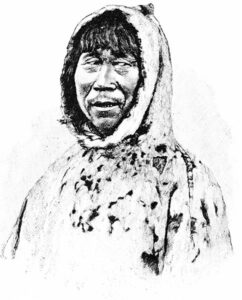Much like the incredibly well-adapted wildlife of the Arctic, the first indigenous peoples evolved physically and culturally to meet the rigorous demands of their remarkable environment. No one knows for sure when and how the first people colonized the Arctic but many think that the first people of the North American Arctic came from Asia 30,000 or more years ago.
Today’s Inuit people descended from the Thule, a culture that established itself during one of the Arctic’s periodic warming trends, a time called the climatic optimum, around 900-1100 A.D. During the optimum, the numbers of marine animals off the Arctic coasts were incredibly abundant. The creative development of sealskin boats, kayaks, and dog sleds helped to colonize new areas of the high Arctic. However, a cooling trend which lasted for more than 700 years followed the climatic optimum. This resulted in the breakup of the Thule society and isolated cultures, separated by vast expanses, returned the Arctic’s inhabitants to a struggle for survival.
It was during this time that the first European explorers ventured toward the Arctic. History is uncertain, but the first European to likely sail close enough to the Arctic to see drifting pack ice was a Greek adventurer named Pytheas, around 325 B.C. His great journey probably took him to what is now either Iceland or Norway. A thousand years later the adventurous Norsemen visited the Arctic. By the turn of the 9th century, they had begun to colonize Iceland, again during years of climatic optimum. When the next cold spell began these settlements disappeared. Much later, British expeditions by Sir Martin Frobisher, then Henry Hudson and William Baffin mapped much of the Canadian Arctic.
The 18th century was the heyday of Russian exploration of the Arctic; however, that nation’s most famous and successful navigator was a Dane named Vitus Bering. Between 1725 and 1741, Bering and a number of Russian explorers discovered Arctic islands, mapped the northern Siberian coastline and sailed the passage that runs between Siberia and northernmost Alaska, the Bering Strait. The early European explorers experienced the cruel climate on pitifully prepared expeditions.
Arctic exploration in the 19th century had its tragic outcomes as well. In 1846, Sir John Franklin of Britain set out to explore the North American Arctic Ocean with two ships which both became cought in sea ice. For three years, the crewmen waited for rescue, during which time many died, including Franklin himself. Finally, the desperate survivors attempted to hike south and all of them perished in the effort. This disastrous attempt did, however, lead to many discoveries of the Arctic. Through the massive rescue attempt, other explorers mapped vast expanses of the Arctic coastline.
Finally, in the 20th century a successful American expedition to the Arctic took place. In the early 1900s, Robert Peary chose a different method to successfully attempt to be the first man to reach the North Pole. Peary was the first explorer in the arctic who prepared to face its harsh conditions using Native ways for survival strategies. He dressed in Native parkas, used Native dog sleds and employed Native guides. On April 6, 1909, Robert Peary, accompanied by Matthew Henson and four Native guides, whose names seem not to be recorded, reached the top of the world.
This diverse and often tragic history is only a brief sketch of some of the explorers of this harsh northern terrain. The remarkable humans who could devise ingenious strategies as complex as any of the animls were the intrepid survivors who could call the Arctic their home.




